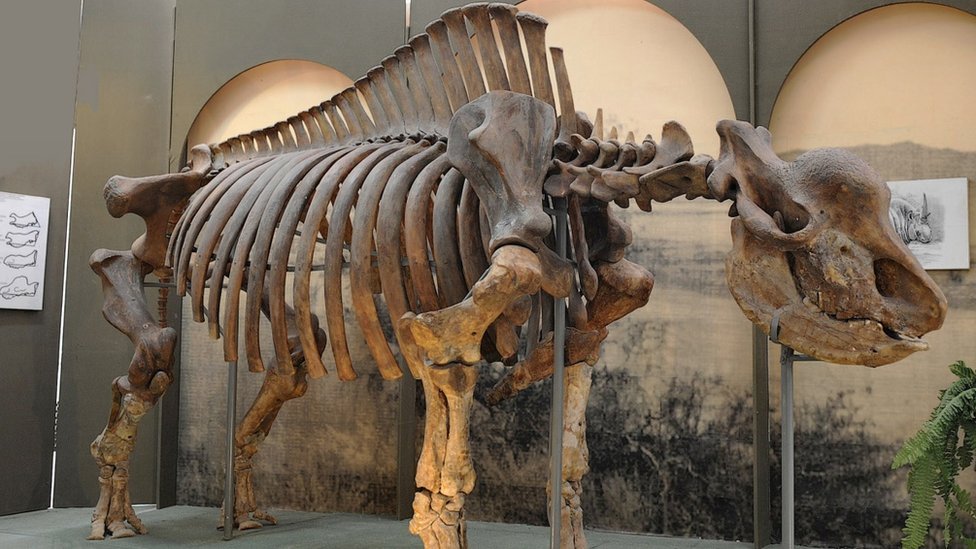Elasmotherium Sibiricum Fossil | A more recent date of 26,000 bp is considered less reliable. Elasmotherium is an extinct genus of large rhinoceros endemic to eurasia during the late pliocene through the pleistocene, existing from 2.6 ma to at least as late as 39,000 years ago in the late pleistocene. On the fossil rhinoceros elasmotherium. The fossil elasmotherium sibiricum was previously believed to have gone extinct approximately 350,000 years ago. Fossils have been found in europe and asia.
Elasmotherium is an extinct giant rhinoceros. Fossils have been found in europe and asia. Elasmotherium or the giant siberian unicorn is quite common in siberia and adjacent regions in the past century, quite a number of specimens of elasmotherium were recovered in nihewan basin. The fossil elasmotherium sibiricum was previously believed to have gone extinct approximately 350,000 years ago. Elasmotherium sibiricum skull cast at the museum für naturkunde, berlin.

Caucasicum, as you can infer by its name, was the third species, e. Discover the ancient rhino species elasmotherium sibiricum, known as the siberian unicorn. It lived from 2.6 million years ago (mya) to about 50,000 years ago. Fossil animal elasmotherium and as species name. Elasmotherium sibiricum skull cast at the museum für naturkunde, berlin. Elasmotherium consists of three species. Painting of the elasmotherium sibiricum or 'siberian unicorn' by heinrich harder. It lived from 2.6 million years ago (mya) to about 50,000 years ago. Fossils have been found in europe and asia. A siberian unicorn fossil, elasmotherium sibiricum has been discovered in kazakhstan. Before now, researchers thought the creature went extinct 350,000 years ago, but studies now reveal the unicorn. Elasmotherium is an extinct giant rhinoceros. Sibiricum, or siberian unicorncitation needed was the size of a mammoth and is thought.
It lived from 2.6 million years ago (mya) to about 50,000 years ago. Caucasicum, as you can infer by its name, was the third species, e. Kidzsearch.com > wiki explore:web images videos games. They are the only current rhinoceros in the game, and are the second largest mammals in the game, the largest being the mammoth. Elasmotherium or the giant siberian unicorn is quite common in siberia and adjacent regions in the past century, quite a number of specimens of elasmotherium were recovered in nihewan basin.

Elasmotherium sibiricum skull cast at the museum für naturkunde, berlin. Elasmotherium sibiricum fue un mamífero que existió durante la época del pleistoceno en el período cuaternario de la era cenozoica. On the fossil rhinoceros elasmotherium. It lived from 2.6 million years ago (mya) to about 50,000 years ago. Fossils have been found in europe and asia. 5 m in length, 230 cm in height, 4500 kg of weight. Elasmotherium is an extinct giant rhinoceros. Elasmotherium is an extinct giant rhinoceros. Scientists believed elasmotherium sibiricum went extinct 350,000 years ago. Elasmotherium consists of three species. Elasmotherium or the giant siberian unicorn is quite common in siberia and adjacent regions in the past century, quite a number of specimens of elasmotherium were recovered in nihewan basin. Caucasicum, as you can infer by its name, was the third species, e. A more recent date of 26,000 bp is considered less reliable.
This giant lived and grazed on the eurasian steppes (grasslands). Elasmotherium consists of three species. Caucasicum, as you can infer by its name, was the third species, e. From wikimedia commons, the free media repository. A more recent date of 26,000 bp is considered less reliable.
A more recent date of 26,000 bp is considered less reliable. Elasmotherium consists of three species. Elasmotherium is an extinct giant rhinoceros. 5 m in length, 230 cm in height, 4500 kg of weight. Kidzsearch.com > wiki explore:web images videos games. Fossils have been found in europe and asia. From wikimedia commons, the free media repository. This giant lived and grazed on the eurasian steppes (grasslands). Reconstructions of elasmotherium and woolly. Elasmotherium sibiricum it was a mammal that existed during the pleistocene epoch in the the dating of the most recent fossils has established that the elasmotherium sibiricum he was able to. These names were published a year after. Elasmotherium sibiricum skull cast at the museum für naturkunde, berlin. It lived from 2.6 million years ago (mya) to about 50,000 years ago.
Elasmotherium sibiricum skull cast at the museum für naturkunde, berlin elasmotherium sibiricum. Elasmotherium sibiricum skull cast at the museum für naturkunde, berlin.
Elasmotherium Sibiricum Fossil! Reconstructions of elasmotherium and woolly.